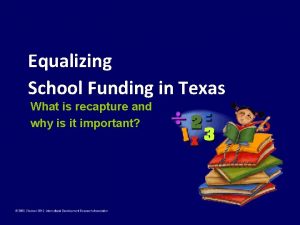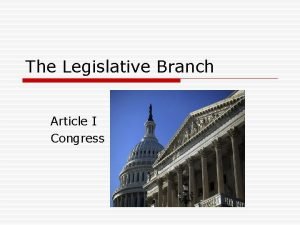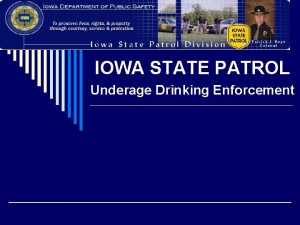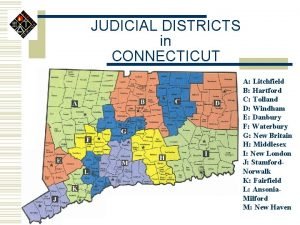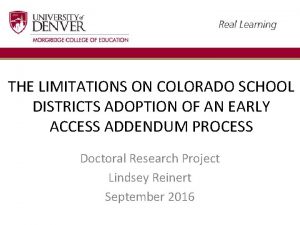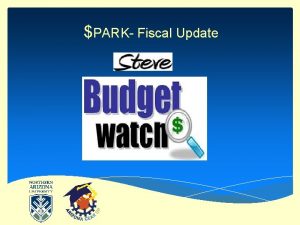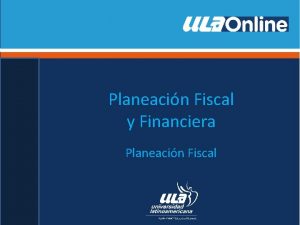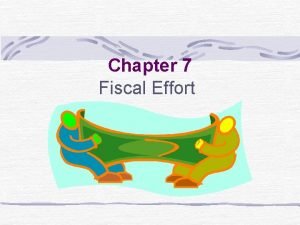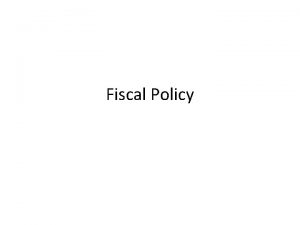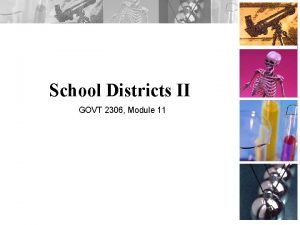Fiscal Health Analysis of Colorado School Districts August





























- Slides: 29

Fiscal Health Analysis of Colorado School Districts August 2011 Office of the State Auditor 1

Agenda for today’s presentation � Analysis � Roles and ratios of the OSA and CDE � Trends and evaluation of ratios � Factors that impacted 6 school districts 2

Background – Roles of OSA & CDE � 178 school districts in Colorado � Funding sources � Colorado Department of Education (CDE) ◦ Oversight & monitoring of accreditation � Office of the State Auditor ◦ Compliance with Local Government Audit Law ◦ Authority to hold property taxes ◦ Review of audit report 3

Background – Roles of OSA & CDE � Public School Transparency Act ◦ CDE monitors through financial accreditation process � Development of Fiscal Health Analysis ◦ Three year period to review ◦ Focus on areas of highest risk – General Fund ◦ Debt and changes in fund balance 4

Ratio 1: Asset Sufficiency Ratio � Are assets larger than liabilities? � Formula: General fund total assets General fund total liabilities � Warning trend: A consistent deficit in assets’ adequacy to meet obligations over the 3 -year period. 5

Ratio 2: Debt Burden Ratio � Do annual revenues cover debt service payments? � Formula: Total governmental revenue of fund(s) paying debt Total governmental debt payments � Warning trend: Annual revenues consistently below the annual debt payment for each of the three years. 6

Ratio 3: Operating Reserve Ratio � How long will reserves last for future expenditures? � Formula: Fund balance of the general fund Total general fund expenditures (net transfers) � Warning trend: A reserve that covers less than 1 week of future expenditures, which is the equivalent of. 0192, or 1/52, for each of the 3 years. 7

Ratio 4: Operating Margin Ratio � How much is added to reserves for every dollar generated in revenues? � Formula: General fund total revenue – (general fund total expenditures (net) General fund total revenues � Warning trend: A loss in reserves for each of the 3 years. 8

Ratio 5: Deficit Fund Balance Ratio � How much revenue does it take to cover a deficit fund balance? � Formula: Total (absolute value) deficit fund balance – positive fund balance of the general fund Total revenue in deficit fund balance(s) � Warning trend: The portion of annual revenue needed to cover the deficit fund balance is increasing over the 3 -year period. 9

Ratio 6: Change in Fund Balance Ratio � Are reserves increasing or decreasing? � Formula: Current year fund balance of the general fund – prior year fund balance Prior year fund balance of the general fund � Warning trend: Consistent decreases in reserves. 10

Trend analysis � Purpose ◦ Warning trends over three year period ◦ 2008, 2009, 2010 � Limitations ◦ Warning indicator in one year ◦ Current budgetary actions 11

Warning Indicators � 26 school districts with one or more ◦ 20 districts with one ◦ 5 districts with two ◦ 1 district with three 12

State of Colorado Fiscal Health Analysis School Districts With Warning Indicators For the Three-Year Period Ending June 30, 2010 Ratio 1: Ratio 2: Ratio 3: Fiscal Health Ratio Asset Sufficiency Ratio Debt Burden Ratio Operating Reserve Ratio 4: Operating Margin Ratio 5: Deficit Fund Balance Ratio 6: Change in Fund Balance Ratio Total Indicators Total Districts With One or More Indicators Number of Districts with Warning Indicator 1 0 13 As of June 30, 20092 0 7 As of June 30, 20083 2 7 0 16 0 40 2 33 0 0 0 6 35 21 68 17 61 26 49 43 Source: 1 2 3 Analysis performed by the Office of the State Auditor, Local Government Audit Division using data from audited financial statements submitted by school districts. Some districts had indicators in more than one category. Number of districts with indicators in prior analysis, which covered the three-year period ending June 30, 2009. Number of districts with indicators in prior analysis, which covered the three-year period ending June 30, 2008. 13

Warning Indicators � Warning indicators do not always mean there is a problem ◦ Planned capital expenditures ◦ Deliberate spending of reserves � However – the more warning indicators, the greater the risk ◦ Identify potential problems early 14

Appendices � Appendix A � Appendix B � Appendix C � Appendix D ◦ Ratio descriptions, calculations, benchmarks, warning indicators ◦ Districts with two or more warning indicators ◦ Comparison with prior year ◦ District responses ◦ Map ◦ Data for all school districts 15

Districts with Two Warning Indicators � Otis R-3 (Washington County) � Ouray R-1 (Ouray County) � Jefferson � Buena � La County (Jefferson, Broomfield) Vista R-31 (Chaffee County) Veta RE-2 (Heurfano County) 16

Districts with Two Warning Indicators � Not necessarily a problem � Reasons centered around three themes ◦ Various planned expenditures ◦ Reductions in state school finance funding ◦ Capital improvements � Plans to correct the situation ◦ Budget cuts ◦ Further spend down of fund balance ◦ Apply for grants 17

Follow up from Prior Year � 19 districts identified with two in 2010 ◦ Majority showed improvement ◦ 13 districts had one last year – none this year ◦ 3 districts decreased from two to one � Four districts with warning indicators in all three Fiscal Health Analysis reports ◦ ◦ Hoehne Platte Valley RE-3 Pritchett RE-3 Widefield 3 18

Follow up from Prior Year � Overall number of districts with warning indicators has declined ◦ 2011 – 6 districts ◦ 2010 – 19 districts ◦ 2009 – 15 districts 19

District with Three Warning Indicators � Hoehne Reorganized 3 (Las Animas County) ◦ Debt Burden ◦ Operating Margin ◦ Change in Fund Balance 20

Warning Indicators � Debt burden ratio ◦ Decline in the ratios over the three year period ◦ 2010 ratio less than one � Operating margin ratio ◦ Decrease over the three year period ◦ All three years less than zero � Decline in fund balance ratio ◦ Decline in the ratios over the three year period ◦ 2010 ending fund balance less than 2008 beginning fund balance. 21

Calculations for Hoehne � Debt burden ratio Revenue in funds making debt service payments Annual debt service payments $166, 083 $185, 400 � Ratio calculation: . 90 22

Calculations for Hoehne � Operating margin ratio General fund total revenue –(general fund total expenditures (net) General fund total revenues 2008 2009 2010 General Fund Revenues $3, 052, 945 3, 180, 569 3, 692, 252 Expenditures $3, 241, 735 3, 285, 164 3, 823, 548 23

Calculations for Hoehne � Operating margin ratio General fund total revenue –(general fund total expenditures (net) General fund total revenues 3, 692, 252 – (3, 823, 548+135, 000) 3, 692, 252 � Ratio calculation: (0. 07) 24

Calculations for Hoehne � Change in fund balance ratio Current year fund bal of the general fund – prior year fund balance Prior year fund balance of the general fund General Fund Balance 2008 Beginning 2008 2009 2010 $1, 659, 887 1, 385, 765 1, 084, 294 775, 206 25

Calculations for Hoehne � Change in fund balance ratio Current year fund bal of the general fund – prior year fund balance Prior year fund balance of the general fund 775, 206 – 1, 041, 502 � Ratio calculation: (0. 26) 26

Hoehne School District � Causes: uncollected property taxes ◦ 6% of total General Fund revenues ◦ Applied for financial assistance � Solutions: ◦ Spending limits ◦ Reductions in staff ◦ Checks and balances 27

Hoehne School District � Presentation Committee to the Legislative Audit ◦ Hoehne Superintendent ◦ CDE 28

Conclusion � Important � Early analytical tool warning system � Allows school districts to take prompt action 29
 Colorado springs school districts
Colorado springs school districts Maine dhhs districts
Maine dhhs districts Maine public health districts
Maine public health districts Texas public school finance overview
Texas public school finance overview Texas recapture districts
Texas recapture districts Sharecropping and tenant farming venn diagram
Sharecropping and tenant farming venn diagram Texas recapture districts
Texas recapture districts East odisha districts
East odisha districts Define delimit demarcate administrate
Define delimit demarcate administrate Zoning districts
Zoning districts Maharashtra district in 1960
Maharashtra district in 1960 Ddd education
Ddd education A student who lives in minneapolis chooses to spend
A student who lives in minneapolis chooses to spend Arizona congressional districts
Arizona congressional districts Iowa state patrol districts
Iowa state patrol districts Russia federal districts
Russia federal districts 1. from where does kat recognize the girl with red hair?
1. from where does kat recognize the girl with red hair? What are the districts in paris called
What are the districts in paris called Chera chola pandya history
Chera chola pandya history Philippine association of water districts
Philippine association of water districts Connecticut judicial districts
Connecticut judicial districts Category 5 and 6 local authority districts
Category 5 and 6 local authority districts What is troy maxson job and how is it symbolic
What is troy maxson job and how is it symbolic Maryland physician health program
Maryland physician health program Colorado health neighborhoods
Colorado health neighborhoods Colorado health op
Colorado health op Colorado health information exchange
Colorado health information exchange Colorado physician health program
Colorado physician health program Colorado asbo
Colorado asbo Casbo colorado
Casbo colorado






